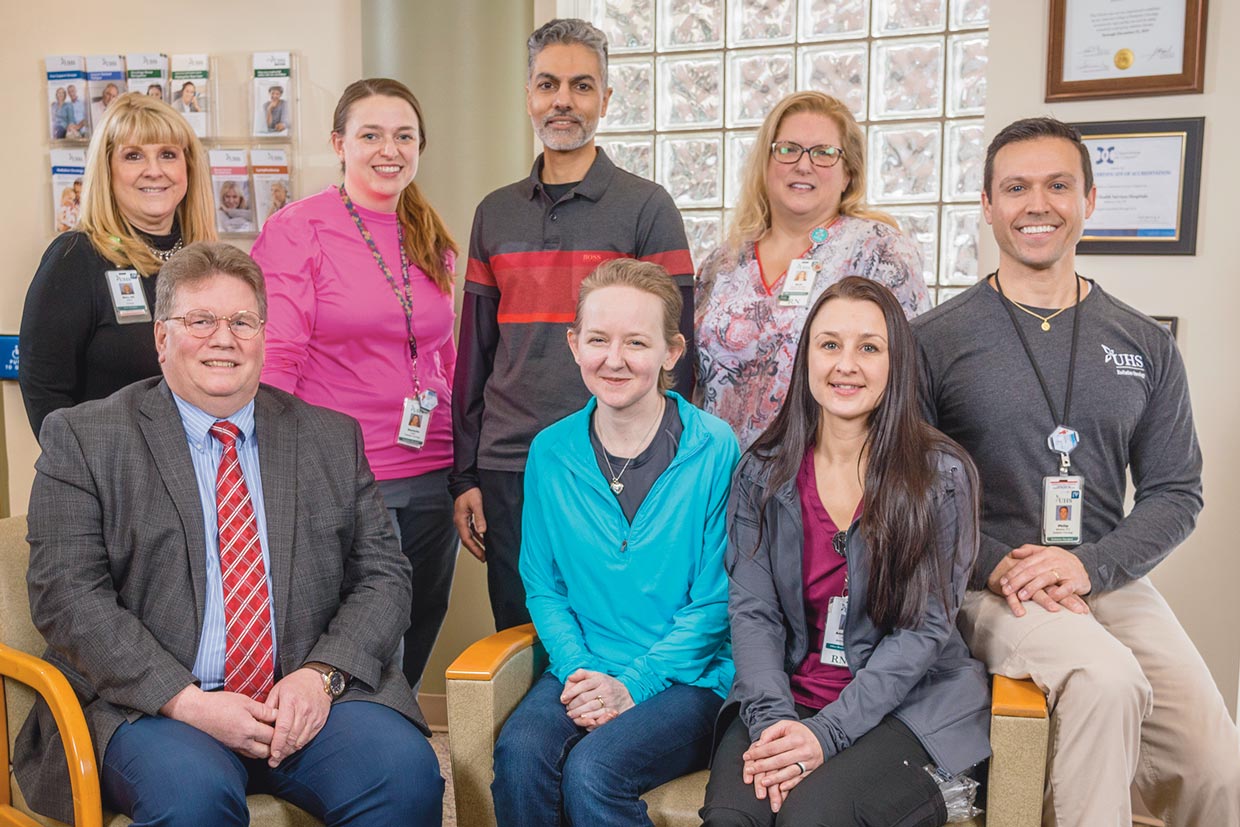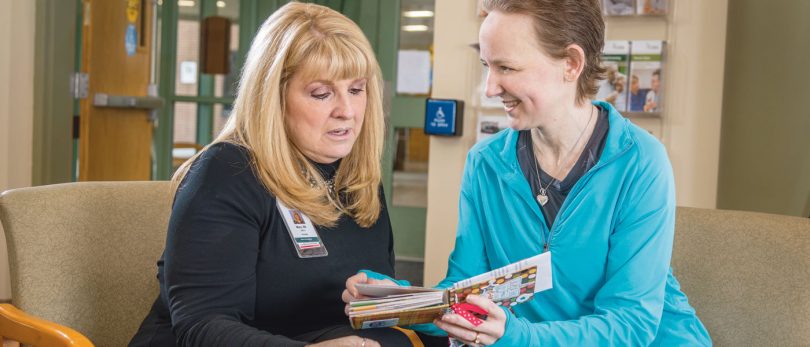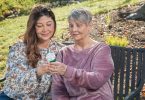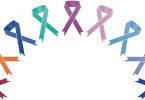In early 2018, Franklin Forks, Pa., resident Deborah Kessler was energetic and fit. She had run several half-marathons previously and was excited about running her first full marathon. She completed the race in good time, but a few days later she was experiencing strange pains in different parts of her body.
“I couldn’t straighten my arm out,” recalled Ms. Kessler, who added a yoga class to her routine, hoping that the stretching would help ease the aches. When the pain settled in her back, she went to a chiropractor. By March, Ms. Kessler was in so much pain that she went for an MRI.
The news was not good. The MRI and additional tests showed that Ms. Kessler had metastatic cancer in her bones, lymph nodes and brain. Her pain was becoming severe, and her physicians felt it was best that she start radiation treatments right away to help ease the pain and prevent further growth and spread of the metastases.

Deborah Kessler formed a lasting bond with her care team at UHS. Pictured in bottom row (starting at left): Ronald Harris, DO, medical oncologist; Deborah Kessler; Amber Funnell, RN, Medical Oncology. In top row (starting at left): Mary Mancini, RN, oncology nurse navigator; Danielle Lewis, radiation therapist; Rashid Haq, MD, radiation oncologist; Molli Navarro, RN, Radiation Oncology; Philip Messina, radiation therapist.
Starting the fight
Rashid Haq, MD, radiation oncologist at UHS Radiation Oncology, described the treatment plan that was developed for Ms. Kessler. “We treated different areas that showed bony disease,” he explained. “The radiation provided excellent pain control in her spine and left shoulder area. When she was found to also have multiple brain metastases, we were able to treat those to prevent neurological symptoms from those areas of disease. She had headaches, which had prompted the MRI, but neurologically she had been quite well. The spots on the brain were quite small.”
Ms. Kessler kept her spirits up during radiation treatments, even though the treatments—and the disease itself—made her exhausted. “The staff was so amazing,” she says. “Positioning my arm and shoulder for the radiation was difficult, and the mask I had to wear when they were doing the brain treatment made me a little claustrophobic. But they were so patient with me. I had the best of care.”
Discovering the source
As Dr. Haq and the Radiation Oncology team worked with Ms. Kessler on her treatments, other physicians were working to determine exactly what the source of the cancer was. It turned out that even though she had never smoked, the cancer was a type that originated in Ms. Kessler’s lungs. Ronald Harris, DO, UHS medical oncologist, diagnosed Ms. Kessler with stage IV non-small-cell lung cancer, which was caused by a genetic mutation known as ROS1.
Although the ROS1 type is rare, Dr. Harris was hopeful. “This type of cancer makes Deborah an ideal candidate for targeted oral chemotherapy with Xalkori (crizotinib). It will extend her longevity and improve her quality of life.”
“I take the Xalkori two times a day at home,” says Ms. Kessler. “I feel sick for a couple hours after taking it, but it’s not as bad as I thought it would be. I am just so grateful to the researchers who came up with this therapy—without them I wouldn’t be here. Dr. Harris is excellent, and I didn’t have to go to all the way to New York City to get this great care.”
Lung Cancer: Risk Factors, Warning Signs and Screenings
If you have one or more of these risk factors or symptoms, call UHS Nurse Direct at 607-763-5864 to see if you qualify for a screening. Use + to expand.
- Smoking (or history of smoking)
- Second-hand smoke exposure
- Environmental exposure to airborne pollutants or radon
- Family history of lung cancer in parent, sibling or child
Support through the process
Ms. Kessler also had support from Mary Mancini, RN, oncology nurse navigator. “For so much of the first six to nine months, I was just a body in a wheelchair,” says Ms. Kessler. “But Mary was so positive and encouraging. She set up a nutritionist to help me and arranged for what I call my ‘old man’ aerobics.” When the radiation caused Ms. Kessler to lose her hair, there was a volunteer who helped her get a wig.
Initially, she was so ill that she had to use a wheelchair to move around. As her strength returned, she also used her wheelchair as a walker. The Xalkori and a drug that strengthens her bones have helped Ms. Kessler immensely. “At first, they said the cancer was moving so fast, and that I had to be strong for my family. Now, I am so far from where I was.
“I feel that the cancer was this horrible storm swirling around me, but I had peace about it. The Lord put an umbrella over me and the sun was shining underneath.”
Special Deliveries
 Deborah Kessler has had a tough time with her cancer fight, but you wouldn’t know it based on how her optimistic spirit shines. She took time to handcraft journals and thank-you letters to every one of the dozens of people she encountered at the UHS Cancer Center during her care, from the housekeeping staff and parking attendants to administrators and clinicians.
Deborah Kessler has had a tough time with her cancer fight, but you wouldn’t know it based on how her optimistic spirit shines. She took time to handcraft journals and thank-you letters to every one of the dozens of people she encountered at the UHS Cancer Center during her care, from the housekeeping staff and parking attendants to administrators and clinicians.
“Deb was a true inspiration to all of us in the cancer center,” says Mary Mancini, RN, oncology nurse navigator. “She never faltered from her faith and always asked us how our day was and found a way to put a smile on her face.”
LEARN MORE
To find out more about UHS oncology services, visit nyuhs.org.







